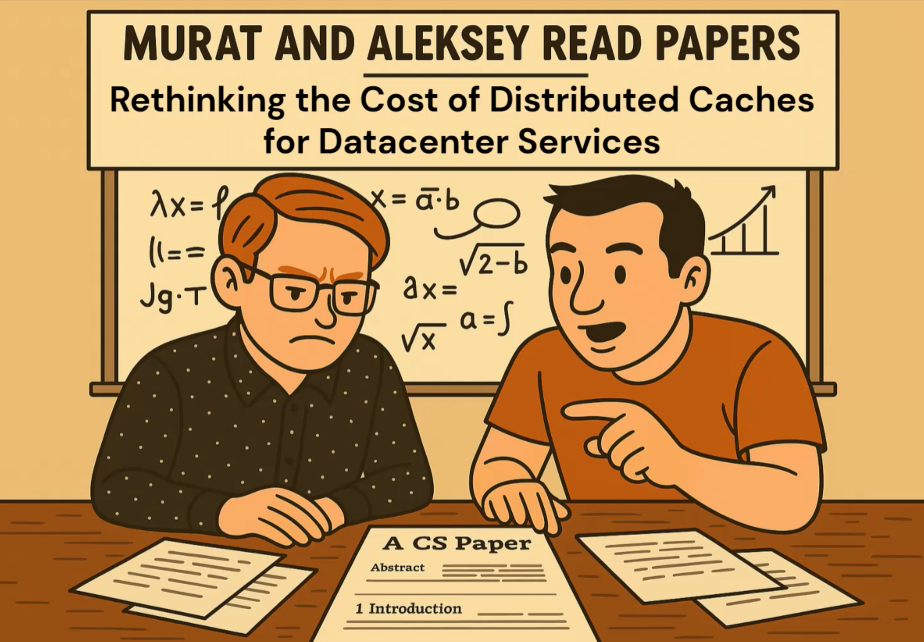One Page Summary
-
Murat and Aleksey Read Papers: “Rethinking the Cost of Distributed Caches for Datacenter Services”

Murat and Aleksey read “Rethinking the Cost of Distributed Caches for Datacenter Services.“ This paper argues that distributed caches can save money by reducing CPU costs despite using substantially more of the costly DRAM. The authors claim up to 4X savings in synthetic and open-source workloads. The paper also calls for richer caching semantics to…
-
One Page Summary. Photons: Lambdas on a diet
Recently, to prepare for a class I teach this semester, I went through the “Photons: Lambdas on a diet” SoCC’20 paper by Vojislav Dukic, Rodrigo Bruno, Ankit Singla, Gustavo Alonso. This is a very well-written paper with a ton of educational value for people like me who are only vaguely familiar with serverless space! The…
-
One Page Summary. Gryff: Unifying Consensus and Shared Registers
This paper by Matthew Burke, Audrey Cheng, and Wyatt Lloyd appeared in NSDI 2020 and explores an interesting idea of a hybrid replication protocol. The premise is very simple – we can take one protocol that solves a part of the problem well, and marry it with another protocol that excels at the second half…
-
One Page Summary. Aegean: Replication beyond the client-server model
One Page Summary. Aegean: Replication beyond the client-server model This paper builds o n a key observation about the operation of complex distributed applications. Namely, microservice style of application rarely follows a simple client-server architecture, where a client makes a request and the server (or servers) respond to a request. Instead, many applications often use…
-
One Page Summary: Ring Paxos
This paper (Ring Paxos: A high-throughput atomic broadcast protocol) has been out for quite some time, but it addresses a problem still relevant in many distributed consensus protocols. Ring Paxos aims to reduce the communication load in the Paxos cluster and provide better scalability. As we have shown in our SIGMOD 2019 paper, communication is…
-
One Page Summary: “PaxosStore: High-availability Storage Made Practical in WeChat”
PaxosStore paper, published in VLDB 2017, describes the large scale, multi-datacenter storage system used in WeChat. As the name may suggest, it uses Paxos to provide storage consistency. The system claims to provide storage for many components of the WeChat application, with 1.5TB of traffic per day and tens of thousands of queries per second…
-
One Page Summary: Flease – Lease Coordination without a Lock Server
This paper talks about a decentralized lease management solution. In the past, many lock/lease services have been centralized, placing a single authority to manage all locks in the system. Google’s Chubby, Apache ZooKeeper, etcd, and others rely on a centralized approach and backed by some flavor of a consensus algorithm for fault-tolerance. According to Flease authors,…
-
One Page Summary: “milliScope: a Fine-Grained Monitoring Framework for Performance Debugging of n-Tier Web Services”
Authors of the ICDCS2017 milliScope paper attack an interesting monitoring problem for distributed systems: detecting and determining a cause of short-lived events in the system. In particular, they address the issue of identifying very short bottlenecks (VSBs) in distributed web services. VSBs manifest themselves as performance degradation of a small number of requests, however they…
-
One Page Summary: “Musketeer: all for one, one for all in data processing systems”.
Many distributed computation platforms and programming frameworks exist today, and new ones constantly popping out from the industry and academia. Some platforms are domain specific, such as TensorFlow for machine learning. Others, like Hadoop and Naiad are more general, and this generality allows for sophisticated and specialized programming abstractions to be built on top. So…
-
One Page Summary: “Slicer: Auto-Sharding for Datacenter Applications”
One of the questions engineers of large distributed system must answer is “where to compute”. This is a big and important question, as we do not want to send a request originating in the US to some server in Australia. It simply makes no sense to incur the communication overhead if there are resources available…
Search
Recent Posts
- Murat and Aleksey Read Papers: “Rethinking the Cost of Distributed Caches for Datacenter Services”
- On Metastable Failures and Interactions Between Systems
- Murat and Aleksey Read Papers: “Barbarians at the Gate: How AI is Upending Systems Research”
- Academic Chat with Murat and Aleksey: 5 Cs of the Invisible Curriculum.
- HoliPaxos: Towards More Predictable Performance in State Machine Replication
Categories
- One Page Summary (11)
- Other Thoughts (14)
- Paper Review and Summary (16)
- Pile of Eternal Rejections (2)
- Playing Around (14)
- Reading Group (104)
- RG Special Session (4)
- Teaching (2)